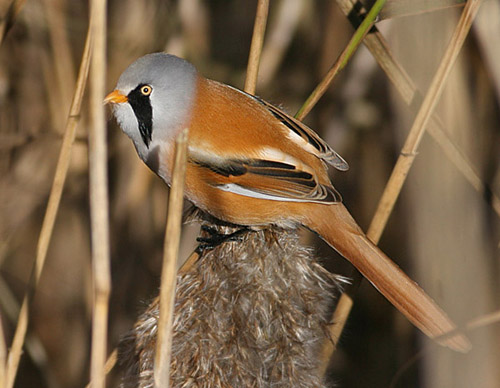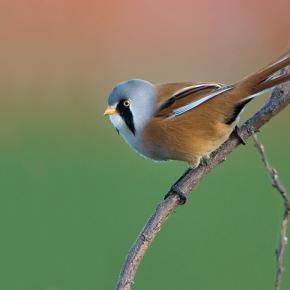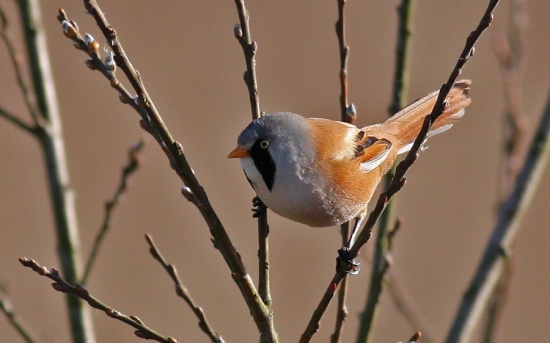
Panurus biarmicus
SUBFAMILY
Paradoxornithinae
TAXONOMY
Parus biarmicus Linnaeus, 1758, Holstein. Three subspecies.
Some classification systems have placed this species and other
parrotbills in separate family (Panuridae or Paradoxornithidae),
but Delacour considered them
SUBFAMILY
within babblers. DNA
hybridization research suggests they may belong in the same
SUBFAMILY
(Timaliinae) as most babblers.
OTHER COMMON NAMES
English: Bearded tit, marsh pheasant (East Anglia); French:
Mesange a moustaches; German: Bartmeise; Spanish: Bigotudo.
PHYSICAL CHARACTERISTICS
5 in (12.7 cm). Highly sexually dimorphic. Male unmistakable:
unique elongated black feathers in front of eye droop down to
chest, forming a “moustache” that contrasts strikingly with orange
eyes and bill; gray head, white throat, warm brown mantle,
rump, and tail, black-white-and-brown-patterned wings,
and black vent. Female: long-tailed, compact-bodied bird like
male, with similarly patterned wings, and orange eyes and bill,
but otherwise generally buffy-brown. Juvenile male very distinct:
gray eyes set in black mask, black back, black on tail, and
overall golden color. Legs black and unusually long.
DISTRIBUTION
Scattered range in British Isles and western and central Europe,
then broadly across central and northeastern Asia to the
Pacific (Bokai Sea). Accidental to Japan.
HABITAT
Wetlands, especially Phragmites reed beds.
BEHAVIOR
European populations essentially nonmigratory, but inclined to
wander in winter, and severe weather may cause wholesale relocations.
East Asian populations appear to regularly migrate
from interior to coast in winter. Highly gregarious and social
outside of breeding season. Complex series of communication
calls and displays. Usual flock size 10–20. Noted for skillful negotiation
through reed beds, typically grasping a different stalk
in each foot. Also capable of what Otto Koenig termed “flutterswimming,”
should bird fall in water.
FEEDING ECOLOGY AND DIET
Remarkable seasonal changes in digestive tract. Winter diet
largely Phragmites, Typha and rush (Juncus) seeds. Stomach
then muscular and hard-walled, and bird ingests numerous
small stones. During remainder of year, when diet is mostly insects,
spiders, and snails, stomach is smaller, flaccid, and contains
no, or fewer, stones. Forages both on the ground and in
vegetation.
REPRODUCTIVE BIOLOGY
Adapted to produce large numbers of offspring quickly, in response
to relatively unstable environment. Regularly hatches
three broods a year, sometimes four, and young from earliest
clutch may themselves breed before end of season, in fall. Pairs
mate for life, but nest in loose colonies without territorial
boundaries. Nest is a deep cup of reed leaves and other plants,
lined with reed flower-heads and feathers, located deep amidst
plant stalks, above water, or on land, constructed by both members
of pair, who continue to add material throughout 10–14
day incubation period. Four to eight pale, streaked, and speckled
eggs incubated by both parents, who also raise chick together.
CONSERVATION STATUS
Not threatened, but distinctive, pink-bellied southern Turkish
P. biarmicus kosswigi appears to be extinct. In early nineteenth
century common along the Thames, from the estuary to Oxford,
but British Isles population reduced to two to four pairs
in East Anglia by 1948 due to marsh and fen draining, hard
winters, and private and commercial egg collectors. Since then
British population has increased to more than 500 pairs, at
least partially recolonized from continental Europe during hard
winter dispersals. German range has expanded since the 1950s.
All European populations are closely monitored.
SIGNIFICANCE TO HUMANS
Since the 1990s large numbers were available cheaply from
People’s Republic of China for the captive-bird trade. Export
prohibited by China in 2001, but may continue from Russian
Federation.
Other popular Animals
Photo Gallery of - Bearded reedling




 Animalia Life
Animalia Life